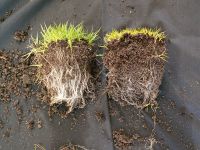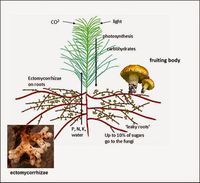Ectomycorrhizal Fungi

Ectomycorrhizal (ECM) is a subgroup of Mycorrhiza, with the other main group being Endomycorrhiza, that form symbiotic relationships with Plant roots. The main difference between Ecto- and Endomycorrhizae is their location with in the root systems they choose to occupy. The word Ectomycorrihiza stems from three Greek words; (ἐκτός ektos, "outside", μύκης mykes, "fungus", and ῥίζα rhiza, "root"). They are most likely found on the outside of roots, they do not penetrate their symbiotic partners roots system. They mainly have relationships with Conifers and Oaks.
Only about 2% of the plant species on earth form endomycorrhizal relationships, but therein exist some of the most environmentally and economically important species. [1] ECM fungi tend towards specificity when choosing hosts, while Arbuscular Mycorrhizal Fungi is much more generalized in its choosing. These communites are an important in many temperate and boreal forests across the world. Mycorrhizae have been around since around the time the first plants started to grow on land around 450 million years ago. They assist the plants (or the plants assist them, this is a chicken and the egg situation) with nutrient uptake that their roots would otherwise be unable to collect. They also provide an added layer in the plants natural defense system by preventing uptake of toxic or harmful materials and pathogens.

Structures

Mantle
A layer encasing the outside of the root tip in either a loose gathering or tight alignment of hyphae. The presence of the mantle can sometimes hinder root hair growth if the root is secured tightly.
Hartig net
A network of hyphae strands that work around epidermal and cortical root cells, as they make their way through the cortex towards the middle of the root. [4]
Extraradical hyphae
A fine network of hyphae that extend outward from the encased root, filling the role of the suppressed root hairs. By spreading out into the surrounding soil, the hyphae can extract water and nutrients for transport back to the root.
Fruiting bodies
The most recognizable part of an ECM relationship is the fruiting body. These growths are usually easy to spot with the naked eye. The function of the fruiting body is sexual reproduction to spread the fungus to new hosts.
Symbiotic relationship with plant roots

In order to attract and form an ECM relationship, plants release metabolites, or small molecules, that encourage hyphae to grow in the direction of the plant root. [7] Flavonoids are one example of a metabolite exuded by plant roots. [8] Once the hyphae approach and penetrate the outer membrane of the root cap, the fungus can begin to infect the plant. Even though the plant has essentially invited the fungus to infect its roots, some natural defenses still exist and resist the invasion by default for up to 21 days, in some cases. [3]
Relationship in action
Once the fungus has infected the plant roots and the epidermal cells, the mantle can form. Upon initial colonization, increased polypeptide synthesis has been observed. [9] Arguably the most important function of mycorrhizal fungi as a whole is its propensity to aid in the uptake of nitrogen. [10] Used in chlorophyll, enzymes, and amino acids within the plant, nitrogen is required for most vital bodily processes. Partnerships with mycorrhizal fungi allow for plants to have a leg up on competitors who do not have the privilege of fungi assistance to draw in more nutrients for use.
Process of nutrient transport
Nutrients are absorbed from the surrounding soil and transported to the plant roots through the use of three components. The interfaces essentially describe the fairly obvious flow of nutrients.
1: Soil-fungus interface
2: Fungus-apoplast interface
3: Apoplast-root interface
Once nutrients have reached the fungus-apoplast interface, the fungus keeps some of the acquired nutrients to maintain its own homeostasis. Up to 86% of the host's nitrogen requirements can be provided by the fungus, while keeping around 15% of the plant's net primary productivity. [11]
Impacts
While Ectomycorrhiza play an important role when they are present, it is estimated that they only have formed relationships with around two percent of plant species. This is a small number, but when they are present they can influence and help establish around thirty percent of the soil bacteria mass. The ECM fungi are an important part in ecosystems such as Boreal forests. They relay on their partner organism (trees) just as much as the trees relies on them. They can both survive without the other, but together they can prosper and even survive where they could not if alone. When present they can account for 10-30% of the assimilated carbon the host plant synthesizes. ECM also break down inorganic substances with its special enzymes that the plant can not, making such substances biologically available for uptake.
Agriculture

Due to the type and style (method) of agriculture most modern farmers practice, we do not see Ectomycorrhiza yet we do see mycorrhizas form Arbuscular Mycorrhizal Fungi. When it comes to harvesting trees on tree farms or restoration (read below), just planting a tree in the soil is not a guarantee that the tree is going to survive, let alone prosper. In order for trees to prosper, they need to be planted within their native range. If not, ECM biomass needs to be implanted in order for them to have a chance at survival. Without their respective symbiotic partners in the soil, some tree species can struggle with the uptake of nutrients needed to survive, especially in a climate or area in which they would normally struggle to survive.
Restoration
In harvest or restoration projects, the trees being introduced may need to be transferred with ECM from their native range. If a tree is being located outside of an area where its species is currently present, then it is much harder for it prosper without the novel mycorrhizae species it has evolved with being present in the soil. Knowing this relationship, when trying to restore old forest back to their former states, it makes sense that we should consider the condition and health of the soil also what species are present in it and which plant species are associated with them. Just like planting trees that don't like wet conditions (bogs, swamps) makes no sense, so should planting trees in/or without mycorrhizae that correlate and they evolved along side with other the past 400+ million years.
Role in spread of invasive species
Ectomycorrhizal fungi are more specialized in their formation of symbiotic relationships, so they are not hugely involved in the spread of non native species. That said, eucalypt and pine trees are obligate EcM trees and are often grown en masse on plantations, sometimes for commercial use. [5] In New Zealand, Pinus contorta has gained a foothold in natural ecosystems with the help of EcM relationships [6] Pinus contorta is native to the western United States and now compete with co-ocurring with native Nothofagus solandri var. cliffortioides.
References
[1] Tedersoo, Leho; May, Tom W.; Smith, Matthew E. (2010). "Ectomycorrhizal lifestyle in fungi: global diversity, distribution, and evolution of phylogenetic lineages" (PDF). Mycorrhiza. 20 (4): 217–263. doi:10.1007/s00572-009-0274-x. PMID 20191371.
[2] Dighton, J. "Mycorrhizae." Encyclopedia of Microbiology (2009): 153-162.
[3] Smith, Sally E.; Read, David J. (26 July 2010). Mycorrhizal Symbiosis. Academic Press. ISBN 978-0-08-055934-6.
[4] Carlile, M.J. & Watkinson, S.C. (1994) The Fungi. Academic Press Ltd, London. pp 329 - 340.
[5] Díez, Jesús. "Invasion biology of Australian ectomycorrhizal fungi introduced with eucalypt plantations into the Iberian Peninsula" (PDF). Issues in Bioinvasion Science. 2005: 3–15. doi:10.1007/1-4020-3870-4_2.
[6] Dickie, Ian A.; et al. (2010). "Co‐invasion by Pinus and its mycorrhizal fungi". New Phytologist. 187 (2): 475–484. doi:10.1111/j.1469-8137.2010.03277.x. PMID 20456067.
[7] Egerton-Warburton, L. M.; et al. (2003). "Mycorrhizal fungi". Encyclopedia of Soils in the Environment.
[8] Martin, Francis; et al. (2001). "Developmental cross talking in the ectomycorrhizal symbiosis: signals and communication genes". New Phytologist. 151 (1): 145–154. doi:10.1046/j.1469-8137.2001.00169.x.
[9] Hilbert, Jean-Louis; Costa, Guy; Martin, Francis (1991). "Ectomycorrhizin synthesis and polypeptide changes during the early stage of eucalypt mycorrhiza development" (PDF). Plant Physiology. 97 (3): 977–984. doi:10.1104/pp.97.3.977.
[10] Chalot, Michel; Brun, Annick (1998). "Physiology of organic nitrogen acquisition by ectomycorrhizal fungi and ectomycorrhizas". FEMS Microbiology Reviews. 22 (1): 21–44. doi:10.1111/j.1574-6976.1998.tb00359.x.
[11] Peay, Kabir G.; et al. (2007). "A strong species–area relationship for eukaryotic soil microbes: island size matters for ectomycorrhizal fungi" (PDF). Ecology Letters. 10 (6): 470–480. doi:10.1111/j.1461-0248.2007.01035.x.
[12] Tedersoo, Leho, et al. “Ectomycorrhizal Lifestyle in Fungi: Global Diversity, Distribution, and Evolution of Phylogenetic Lineages.” SpringerLink, Springer-Verlag, 16 Sept. 2009, link.springer.com/article/10.1007/s00572-009-0274-x.
[13] Ruotsalainen, A. L., et al. “Mycorrhizal Colonisation .” SpringerLink, Springer Netherlands, 8 Mar. 2008, link.springer.com/article/10.1007/s10661-007-0152-y.
[14] The Role of Ectomycorrhiza in Boreal Forest Ecosystem, L. Qu, K. Makoto, D. S. Choi, A. M. Quoreshi, T. Koike